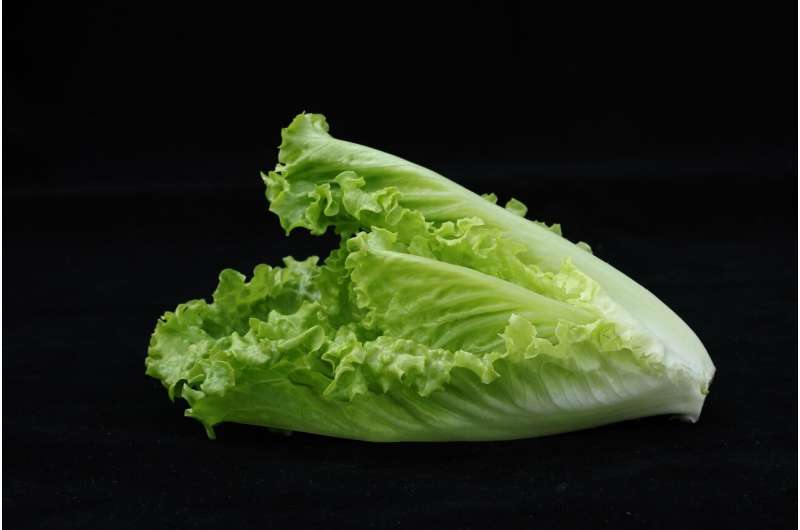Science
Researchers Identify Strategies to Enhance Romaine Safety

Public health experts are intensifying efforts to ensure the safety of romaine lettuce, a popular leafy green that has been linked to multiple foodborne illness outbreaks. Between 2000 and 2020, the Centers for Disease Control and Prevention (CDC) reported at least 42 outbreaks associated with romaine lettuce. Despite these concerns, consumer demand remains strong, with Americans spending more on romaine than on any other type of leafy green.
A recent study published in Scientific Reports outlines a series of interventions aimed at reducing contamination risks throughout the romaine supply chain. The paper, co-authored by Renata Ivanek, a professor at Cornell University, and Martin Wiedmann, a food safety expert, proposes a combination of pre-harvest and postharvest strategies that could significantly enhance consumer safety.
Strategies for Reducing Contamination
The authors emphasize the importance of addressing contamination sources, particularly concerning irrigation practices. “This study supports the fact that interventions should focus on reducing produce contamination via contaminated irrigation water,” said Wiedmann. The research indicates that much contamination originates from untreated surface water used in overhead spray irrigation systems.
The study suggests that switching to methods such as drip or furrow irrigation could mitigate these risks. While these systems may incur higher costs for growers, they reduce the likelihood that water directly contacts the lettuce leaves, thus lowering the potential for bacterial contamination.
As Ivanek notes, understanding the entire agricultural system is crucial. “We tried to describe the system as holistically as possible to account for different risk factors and how they could cause interactions,” she explained. The research team engaged with an advisory council comprising industry leaders to refine their approach.
Improving Postharvest Safety Measures
In addition to pre-harvest strategies, the study also highlights the need for improved practices in processing facilities. Former research associate Ece Bulut, now a senior analyst for Walmart Sourcing, pointed out that while all harvested lettuce undergoes washing, there are still significant knowledge gaps. “There is a lot of research into how to make that wash better, but details on effective chemical use and contact time remain unclear,” Bulut stated.
Moreover, maintaining proper cold storage temperatures throughout the supply chain is vital. Ivanek warned of a “perfect storm” scenario where contamination occurs at the farm or processing level, followed by improper transportation conditions that allow bacteria to proliferate.
With the current push from Health and Human Services Secretary Robert F. Kennedy Jr. under the “Make America Healthy Again” initiative, there is an increased emphasis on consuming fresh fruits and vegetables, many of which are eaten raw. The interventions discussed in this study aim to provide actionable insights for industry stakeholders and enhance food safety practices.
“The big message is that the American food supply chain is extremely safe compared to other countries,” Ivanek concluded. “We’re exploring how we can make it even safer and where we should put additional effort.”
The findings from this research represent an important step toward safeguarding public health and enhancing consumer confidence in the safety of romaine lettuce. More information about the study can be found in the article titled “Risk assessment of Escherichia coli O157:H7 along the farm-to-fork fresh-cut romaine lettuce supply chain” in Scientific Reports (2025).
-

 Health3 months ago
Health3 months agoNeurologist Warns Excessive Use of Supplements Can Harm Brain
-

 Health3 months ago
Health3 months agoFiona Phillips’ Husband Shares Heartfelt Update on Her Alzheimer’s Journey
-

 Science2 months ago
Science2 months agoBrian Cox Addresses Claims of Alien Probe in 3I/ATLAS Discovery
-

 Science2 months ago
Science2 months agoNASA Investigates Unusual Comet 3I/ATLAS; New Findings Emerge
-

 Science1 month ago
Science1 month agoScientists Examine 3I/ATLAS: Alien Artifact or Cosmic Oddity?
-

 Entertainment5 months ago
Entertainment5 months agoKerry Katona Discusses Future Baby Plans and Brian McFadden’s Wedding
-

 Science1 month ago
Science1 month agoNASA Investigates Speedy Object 3I/ATLAS, Sparking Speculation
-

 Entertainment4 months ago
Entertainment4 months agoEmmerdale Faces Tension as Dylan and April’s Lives Hang in the Balance
-

 World3 months ago
World3 months agoCole Palmer’s Cryptic Message to Kobbie Mainoo Following Loan Talks
-

 Science1 month ago
Science1 month agoNASA Scientists Explore Origins of 3I/ATLAS, a Fast-Moving Visitor
-

 Entertainment2 months ago
Entertainment2 months agoLewis Cope Addresses Accusations of Dance Training Advantage
-

 Entertainment3 months ago
Entertainment3 months agoMajor Cast Changes at Coronation Street: Exits and Returns in 2025









